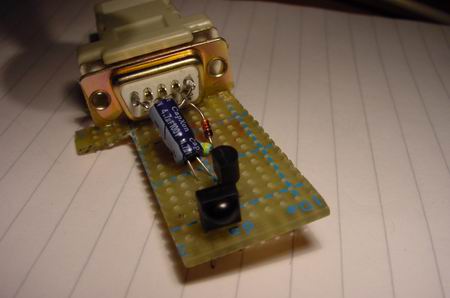Lirc Serial Receiver Howtoprankitup

This instructable intends to show you how to create a small & simple infrared (IR) receiver for your computer. The configuration of the software is beyond the scope of this instructable, but I use this receiver with LIRC (Linux Infrared Remote Control) in Linux. You can read more about LIRC and see the circuit diagram I used to build this at Note that --I did not design this circuit-- and I wasn't the first to put the circuit into a D-sub connector. But I was the first to post an instructable on it, so hopefully someone will benefit from this: ) My total cost was about $1.50 because I had to purchase an IR receiver, but everything else I had lying around because I'm a computer guy/electronics geek. Here are the parts I used, all of them were cannibalized from old projects or scavenged from the engineering lab except the IR receiver that I ordered from Mouser. Parts List: Vishay TSOP1138 IR Receiver 50v 4.7uF capacitor 4001 Diode 4.7K resistor 7805 voltage regulator (5 volts) Parts Discussion TSOP1138 IR Receiver: Most people use the Vishay TSOP 1738, but Mouser was out of those when I ordered and the 1138 is comparable.

Aid File Recovery Software Register Code For Magic Dvd. Lirc Serial Receiver Howtoprankitup. 3/20/2017 0 Comments. Jump to: navigation, search. If your serial device is a receiver, leave LIRC.
And it worked, so who cares: ) 4.7uF capacitor: I used an axial 50v barrel (electrolytic) capacitor because I had one available and didn't want to spend 75 cents at Radio Shack. But, if you've got a 4.7uF ceramic disc capacitor, it would be a lot easier to fit inside the D-sub housing we're going to use. Also, since I used a 50v capacitor and we're only pushing 5v, it's going to have a pretty long rise time but it shouldn't affect the performance of our device too much. 7805 voltage regulator: I used a big one made by Motorola in the first one of these receivers I made and I had to clip the pins very short and clip and grind the top pole in order to get it to fit in the D-sub (see pictures of completed project).
However, when I was digging around for pieces today, I came across a surface mount 7805 that I got from Texas Instruments as a sample years ago. It's tiny and perfect for this project. I'll definitely use it the next time I build one of these as it will cut the footprint of the circuit down tremendously. Both the large and small 7805's are labeled in the electronics closeup picture.
Once again note that I did not create this circuit diagram. Tycoon Peter Jones Ebook Download. It was made by Trimbitas Sori and can be found The only part of this diagram that may require a little explanation is the pins on the serial connector: RS-232 Pinout: 1 = DCD (Carrier Detect) 2 = RXD (Receive Data) 3 = TXD (Transmit Data) 4 = DTR (Data Terminal Ready) 5 = GND (Ground) 6 = DSR (Data Set Ready) 7 = RTS (Request To Send) 8 = CTS (Clear To Send) 9 = RI (Ring Indicator) As you can see from the circuit diagram, we're only using DCD (pin 1), RTS (pin 7), and GND (pin 5). I've included a second image on this page that shows the pin numbers and labels graphically, but all the 9pin D-subs I've ever worked with have been labeled (however microscopically).
Note that this image came from, strangely enough. Just ignore the 'not used' notes because we're totally going to use the DCD pin for our purposes: ) It's pretty hard to give you step by step directions on this part because our goal is to make the thing as small as possible in order to fit it in the D-sub connector.
I'll give you a few pointers but it's going to be up to you to figure out how to make it fit. Pointers: 1) Before you try to make this really small and fit into a tight space, try building the circuit on a breadboard to make sure you can do it (and have all working parts). It will make you extremely angry if you spend an hour cramming/soldering pieces into a D-sub then it doesn't work because you have a dead receiver.
2) Cut the pins on the components down very short. However, remember that you can only make them shorter so don't cut off too much until you're sure of the size you need and that you can still solder to it. OK, I lied a little bit, if you do hack off too much of a pin, you can always solder an extension pin onto it or a small piece of wire that you can run wherever you need (don't be embarrassed, we've all done it: ). 3) Don't use wire to connect the pieces unless absolutely required. Just solder the components directly to each other. I think I ended up using three pieces of wire to make connections because it was impossible to bend the components the way I needed them to fit. Freenas Full Install Xza. 4) Lastly, just solder on one component at a time, then check to make sure you can still fit everything in the D-sub.
If the circuit diagram below doesn't quite make sense to you, I'm going to try to walk you through the assembly in the next step. Some people learn better by having things laid out in text and since we're not using wires I had a little trouble visualizing how everything should be hooked up directly.